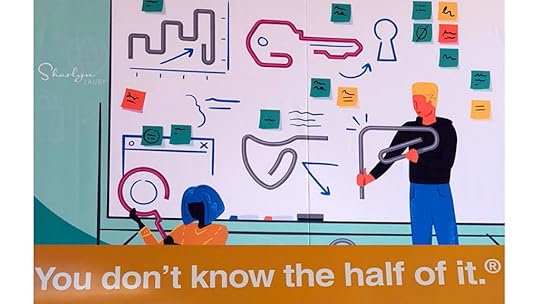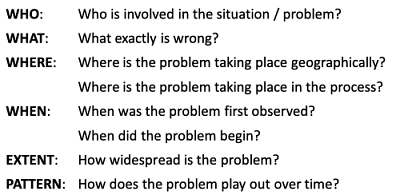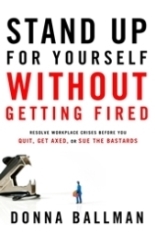Sharlyn J. Lauby's Blog, page 80
July 19, 2020
Organizations: Stay True to Your Values

It’s very difficult for organizations to balance all of the things they have to do. They need to make money so they can hire employees and offer benefits. They have to make products and provide services that their customers will love. And they have to remain true to their values. It’s a sign of credibility.
Over the past few weeks, many organizations have made declarations that they are opposed to systemic racism. But there have been numerous articles pointing out that sometimes what companies say and what they do might not always align.
This is much too important a topic to let it drop on our priority list. Organizations should regularly review their values and ask themselves, “Are we still staying true to our word?” And it starts with the CEO.
Carmen Miller is the CEO of McKinley Insurance Services, a full-service agency located in Fort Lauderdale, Florida. I’ve had the pleasure of knowing Carmen for over a decade. We first met as volunteers at the Society for Human Resource Management (SHRM) annual conference in Orlando. And we spent several years working together on the board for HR Florida, the SHRM state affiliate. I asked Carmen if she would talk about her experiences as a CEO and thankfully, she said “yes”.
Carmen, thanks for being here. What does Black Lives Matter (BLM) mean to you?
[Miller] To me, BLM means that ‘people of color’ and not just Black people, in this country are fed up with repeated injustices that are consciously and continually committed, with no valid repercussions. It is a stand to acknowledge there is a problem and then work toward a solution.
I’ve read a few articles recently that one of the ways white people can show allyship is by supporting Black-owned businesses. As a small business owner, I definitely want to support others and their values. But I’ll be honest, I’m concerned that if I’m vocal about my support that it will be misinterpreted as opportunistic or disingenuous. Are there some tips for showing this type of entrepreneurial support?

[Miller] It is a cautious and discretionary path for sure! You have to walk the walk and talk the talk, all the time, not just now. It can be good as well as bad in affecting business, but realistically, imagine that you even have to think that way.
As a small business owner, never mind as a Black small business owner, I understand it can be difficult to find middle ground, even I struggle with it sometimes. If supporting the ‘movement’ alienates some, to ignore it does the same. It is a Catch-22 either way. It is in no way opportunistic, unless it genuinely is.
Some people do it and say it and you know who is genuine, they have always walked the walk, they have always supported people regardless of color and they do that because they trust that that person/company will do a good job. Many small business owners I know have tried taking the middle ground on this issue to ease all concerns – and many white owners really expect this to blow over in time – so they do just enough to get by. Those are the disingenuous ones. To stand tall at the risk of survival, now that’s real.
Over the years, many organizations have notoriously been apolitical. A few years ago, I attended a conference where CEOs started talking about how their employees were telling them that they needed to take a stand on issues they’ve shied away from in the past (like racial injustice). While many CEOs have been public with their feelings about BLM and racial injustice, I’m sure there are still CEOs who are apprehensive about making political and social statements. As the CEO of your own business, is there something you can suggest to other CEOs that might help them consider what issues they might want to support?
[Miller] CEOs should address issues that are directly affecting their staff and supporters. So, if there is no diversity in the workplace, then they know that’s the perfect place to start. It should be as personal to the CEO as it is to staff and supporters.
I believe this is also an opportunity to look within yourself (company) and see if what the staff is saying is actually happening. Many times, it is. This is where the confusion starts. Many CEO’s don’t know and/or don’t truly understand what the issues are, so the best place to start is within their own organization and the community in which you work and live. Know what affects them. Listen and take action based on your own staff. Start there and then work to support the drive toward resolution.
If you could give people one piece of advice on how to support others and their values during this time, what would it be?
[Miller] Put your own biases aside. We all have them, in some way, shape or form. It may be uncomfortable initially, but you will find that regardless of color, we are all the same.
Stop ‘giving’ money and give time. Give of yourself and actually be with the people who you are supporting. Talk and listen to those who are trying to effect change and learn why they are trying to effect change. Try to understand whatever hits home in the communities you work, live, and serve. Support and assistance are needed in a lot of areas. Choose to stand and be proud of your choice. It’s the only way.

A huge thanks to Carmen for sharing her insights and experience with us. My takeaway from our conversation is that remaining true to our values starts with us. And organizational leaders should make sure that they are setting the example through their actions and those of their organizations, not just talking about it.
Creating organizational equity is going to be a priority for a long-time. Candidate will want to work for companies that demonstrate they have it. Employees will expect it in their job experience. It’s time for organizations to truly live their values.
Image captured by Sharlyn Lauby at the 34th Street Graffiti Wall in Gainesville, FL
The post Organizations: Stay True to Your Values appeared first on hr bartender.






July 16, 2020
Performance Reviews: Overcoming 5 Common Biases

One of the most challenging aspects in the performance review process is overcoming biases. A bias is defined as “a prejudice in favor of or against someone or something”. While all biases are not negative, biases can have a negative impact on employee performance. Employees expect their performance reviews to be fair and free of biases.
Many different kinds of bias can show up during the performance appraisal process. Here are five common ones:
Contrast – This occurs when the manager compares an employee’s performance to other employees instead of the company performance standard. When employees are ranked in comparison, the result is that someone must end up at the bottom, even if they are exceeding the standard. In this situation, the problem isn’t the employee – it’s the goal or standard that has been set.
Halo – An employee is rated highly in all areas because of one thing they do really well. I’ve seen this happen with sales people. The employee achieves their sales goals and senior management loves it. But behind the scenes, they create havoc and don’t have the respect of their co-workers.
Horn – On the flip side, an employee is rated as a poor performer because of one thing they don’t do well. An example would be the accounting clerk who is great at everything but filing. It piles up because they procrastinate – resulting in the company eventually hiring a temp to get the filing caught up. In all other areas, the employee is a high performer.
Leniency – A manager gives everyone on their team a “satisfactory” rating. Unfortunately, I’ve often seen this happen when a manager has a large span of control coupled with a common review date. The manager has dozens of reviews to work on and a heart full of good intentions. But somewhere in the process, the manager gets tired and starts giving everyone a satisfactory rating because it’s easy and doesn’t require any written supporting statements.
Recency – The employee’s most recent behavior becomes the primary focus of the review. The results can go both ways. A poor performer does something terrific and their past performance is forgotten. Or an excellent performer makes a mistake and it weighs down the rest of the review.
If you’re looking for some resources to help managers better understand and handle these biases, I found a couple at a past Society for Human Resource Management (SHRM) Annual Conference. “The First-Time Manager’s Guide to Performance Appraisals” by Diane Arthur goes into biases and much more. This book would be very handy for organizations that don’t need a full-blown performance appraisal training session – maybe because the company has just a handful of managers who give appraisals or only a couple managers need a refresher.
I’d also suggest pairing it with the book “2600 Phrases for Effective Performance Reviews” by Paul Falcone. I know, there are a few people who are anti-phrases books but, for managers who are looking for creative inspiration when it comes to writing about employee performance, it’s helpful. Even for managers with solid writing skills, it’s not always easy to find the right words when an employee needs to improve their performance.
One thing I found useful in the “2600 Phrases” book were the phrases for meeting/exceeding expectations. As a HR professional, I’ve often had to work with managers to make sure when an employee’s performance was being reflected as either meeting or exceeding expectations, it was truly expressed in the proper area. You know, so an employee doesn’t misinterpret “meeting the standard” for “exceeding the standard”.
The more resources we provide to managers, hopefully the less bias we will see in performance reviews and the more comfortable they will get at discussing performance. This benefits employees, the organization, and the bottom-line.
Image captured by Sharlyn Lauby at the 34th Street Graffiti Wall in Gainesville, FL
The post Performance Reviews: Overcoming 5 Common Biases appeared first on hr bartender.






July 14, 2020
My Manager is Threatened By Me – Ask #HR Bartender

Today’s reader note is a very interesting situation and one that I think happens more than we care to admit. Does the manager feel threatened by an employee’s good work?
I worked for this manager for years at a previous company. She left the company, created a job for me, and then recruited me for it. In my first few months, I settled in and got great feedback from stakeholders. My manager knew and trusted me to hum along. Then while my manager was on vacation, the VP worked closely with me on a big project and nominated me for an award.
When my manager returned from vacation, she was furious! She started rejecting the project results that the VP loved, took work away from me, and began a pattern of increasing diversion of work: micromanaging, negative comments, exclusion, interfering in stakeholder communications, yelling at me, ignoring successful projects and positive stakeholder reviews.
The VP likes my work, worked with me, and knows my manner. However, the VP also relies on my manager to help with intense workload.
I sense that I am doomed. It seems like my manager became unhinged when the VP responded well to me. Being conciliatory doesn’t work. I don’t see an option apart from the long shot of transferring. Do you have any advice? I’ve asked for a conversation with the VP, because I can’t take another session of my manager yelling and flipping things over and contradicting herself. Thank you.
I wish I could say that there’s one proven way to deal with these situations. But there’s not. And we don’t know the manager or VP’s sides of the story. What we do know is that the employee needs to make a decision: figure out how to work with the manager or decide next steps. Here are a few articles that might help guide the decision.
These first three articles are focused on the employee’s relationship with the manager.
Getting Your Manager to Recognize Good Work
You do good work. You know that, but you don’t get the recognition you deserve. How do you get your manager to recognize your good work?
How to Tell if Your Boss is a Bully (or Just Tough)
We should not ignore bully claims when a boss just says they are giving “tough love”. We need to make an objective and honest evaluation and act accordingly.
How to Confront a Trash Talking Manager
What can an employee do when they hear their manager trash talking them behind their back? Our friends from the law firm of Foley & Lardner offer some advice.
If an employee feels they need to take action beyond speaking directly with their manager, there are a few places they can turn – human resources, outside lawyer, or a new company. But first, it’s important to ask the question, “What are you hoping will come out of a meeting with the manager’s boss or going to HR?”
When Employees Want to Go on the Record
HR is responsible to the business and the employees. What should HR do when an employee wants to go on the record but in confidence? Attorney Kate Bischoff shares her expertise.
3 Reasons You Might Want to Consider Leaving Your Current Job
Leaving your job is a huge decision that takes careful consideration. Here are 3 reasons you might want to leave your current job.
Employees: When Should You Lawyer Up
Employees may need a lawyer at some point in their career. To help understand why and when you may need a lawyer, these legal experts offer some guidelines.
There’s no doubt that this is a delicate situation. Employees need to think about their future working relationships. That doesn’t mean to dismiss bad behavior. It does mean to spend some time thinking about the desired outcome and the probability of that desired outcome occurring. I’ve seen a lot of employees express concerns and when they’re asked what they want as a result of the conversation, they don’t know. To quote the famous Broadway musical Hamilton, “Don’t miss your shot.”
Image captured by Sharlyn Lauby while exploring the streets of Las Vegas, NV
The post My Manager is Threatened By Me – Ask #HR Bartender appeared first on hr bartender.






July 12, 2020
How to Be a Better Ally – Not An Optical Ally

This is a very long introduction to today’s article. I hope you will indulge me.
A couple years ago, I went to a conference where CEOs were talking about employee activism. Multiple CEOs admitted that over the years they’ve felt it was important to remain neutral when it comes to politics and social injustice. But that they were changing their stance on this because their employees were demanding it. Employees want to know that the companies they work for are going to support what’s just and right.
That doesn’t mean that everyone needs to be a protester. Don’t get me wrong. I have a lot of respect for people who are very vocal about their dissatisfaction with the status quo. But that being said, not everyone has to display their views in the same way to be effective.
I read a quote recently in The Washington Post from Dexter Banks, a Black project manager, in response to the Black Lives Matter movement that said “It’s white people’s participation, that’s the difference. They’re the ones who have to see it.” His comment made me realize I need to find a way to do more as an ally. But I’ll be honest, I’m not a protester. I support Black Lives Matter. I understand that I’m a person of privilege and this isn’t about me. I’m listening and reading. And I’m trying to find ways to do more.
I’ve been getting notes from readers asking how they can be a better ally to the Black community and how they can help their organizations navigate through this change. HR Bartender has always been about providing actionable, practical resources. So, in the hopes of doing just that, I reached out to an HR colleague who has been talking and writing about this for a long time.
Sarah Morgan has been in HR for more than 20 years. She is currently senior director of human resources for a global home security company and the founder of the blog The Buzz on HR (which is where I got to know her work). I asked Sarah if she would share her insights here and thankfully, she said yes.
Sarah, thanks for being here. What does Black Lives Matter mean to you?
[Morgan] To me, Black Lives Matter is a rallying cry for the world to join the fight to dismantle the systems of white supremacy that keep Black people oppressed. This applies to being brutalized and over policed by law enforcement and regular citizens in our communities as well as to being denied full and equal access to wealth, affordable housing, healthcare, and education. It also applies to being consistently marginalized as a people while our cultures and resources are continuously appropriated without recognition or reparations.
As a person of privilege, I know it’s important to read and listen to Black voices to learn to be a better ally. A few years ago, you started the #BlackBlogsMatter movement. Tell us why you started it and how white people (like me) can use it to become more educated.

[Morgan] #BlackBlogsMatter started in 2017 as a 28-day writing challenge to myself to push myself to speak thoughts and feelings surrounding being Black in the workplace and in the world that I had been suppressing.
Over the next 3 years, it blossomed into a movement to advance conversation around the toughest topics in diversity, equity and inclusion within the HR online community space. Several other well-known HR bloggers (Keirsten Greggs, Janine Dennis, Jazmine Wilkes, Tamara Rasberry, Victorio Milian, and Chris Fields, to name a few) joined the annual challenge to amplify the signal and add additional thoughts to the #BlackBlogsMatter conversation. It also created a community of sharing among Black bloggers across all blogging genres.
2020 is the last year of the #BlackBlogsMatter writing challenge. The microblog challenge will continue during Black History Month each year AND the sharing community of Black bloggers will continue to use it to promote their content. I am building a blog roll and influencer program with the #BlackBlogsMatter movement to help Black bloggers to expand their reach and monetize their content. And I have added #BlackPodsMatter to include the growing area of podcasting to the movement’s arsenal.
However, all the #BlackBlogsMatter writing challenge content for the 4 years of the challenge remain available on my blog for anyone who wants to read it now. The content remains very relevant and evergreen. I look forward to the day when we’ve advanced as a society and this content becomes evidence of the way things used to be vs the way things still currently are.
I’m hearing from HR professionals that they want to do more as a Black Lives Matter ally, but they’re concerned about getting pushback from senior management. Specifically, in terms of existing programs (i.e. “We already have diversity and inclusion (D&I) programs. Why do we need to do more?”) Would you say that existing D&I programs are sufficient? And if we need more, what should organizations consider?
[Morgan] Existing D&I programs are not moving the needle to close the gender pay gap. Existing D&I programs are not moving the needle to improve the daily experience of BIPOC at work such that microaggressions, harassment, discrimination, and bullying cease. Existing D&I programs are not creating more opportunity for those with physical and mental disabilities to be accommodated as needed by their employers. Existing D&I programs are not creating a free-flowing pipeline of talent from marginalized communities that can be hired, developed and promoted.
So no, they are not sufficient. The existing D&I programs need to be doing more to make sure that this is what’s happening in the organization’s where D&I programs exist. Because all the cultural celebrations and employee resource groups (ERGs) and other ‘inclusion’ celebratory efforts mean nothing if the issues I mentioned in the preceding paragraph have not and are not being actively addressed.
You’re an “in the trenches” HR professional. What advice would you give to fellow HR pros who have employees saying, “All Lives Matter”? And on the flip side, how can an HR pro address comments such as A.C.A.B.?
[Morgan] First, I need to say that I am more worried about the HR pros who are saying ‘All Lives Matter’ than I am about the employees. Human resources exists to be the gatekeeper and ambassador of the organization’s culture; to ensure we have inclusive and welcoming workplaces. We cannot do that if our own personal response to the outcry from a group of our employees to ongoing harm, pain, and trauma is ‘yeah … but…’. More than any other business focal area, HR has to grasp and be willing to embrace Black Lives Matter for themselves.
It is important to note that many of us are unwilling or unable to do this because of our own internalized supremacy. For HR pros who find themselves struggling with this, I encourage you in the strongest of terms to start working on your own antiracism as soon as possible. Because these kinds of views in HR cause real, tangible harm to people’s lives and livelihoods. I put together a list of resources in this blog post that can help you to get started. These same resources can be shared with other leaders and with employees who need or want help in becoming antiracist. I am also hosting a 2-day workshop in October to help HR professionals work on their antiracism awareness and building equity into their workplace culture.
For HR pros who encounter employees saying, ‘All Lives Matter’, the response is — “yes, all lives matter. However, we need a reminder to those who can’t seem to remember that about Black people so that is why we’re saying Black Lives Matter more loudly in this moment”.
For HR pros who encounter employees saying, “All Cops Are Bad”, the response is – ‘with the brutality we see and with the ‘blue code of silence’, it certainly feels this way. However, not all cops are bad any more than any other profession of people is all bad or all good. What’s important now is putting an end to the brutality and over policing which leaves so many people afraid to call and/or interact with police.’

Last question. If you could give people one piece of advice on how to support others as an ally during this time, what would it be?
[Morgan] Be the most compassionate, considerate and vulnerable version of yourself that you have ever been during this time. At work and at home. With others and with yourself. Be a safe space.
This pandemic coupled with the racial reckoning ignited by the murder of George Floyd have people stressed to levels that most have never seen or known in their lifetimes. I discussed this extensively during my #ReOpeningAfterRona series on my podcast and blog. We are all experiencing what’s known as a ‘discreet crisis with a non-finite loss’ resulting in both coping and support fatigue. This leads to the kind of trauma that you see in people who have survived an active warzone. We will see the effects of this on our minds and bodies for years to come.
While we are still in this moment, it is really important for us to be kind to one another and to ourselves. We have to encourage calm and rest. We have to encourage moments of normalcy and relaxation. We have to encourage thriving thru wellness and community and giving. And, most of all, we have to be honest with ourselves and with our employees so that they feel psychologically safe enough with us as leaders to let us know when and how they are struggling.
That begins with being a role model for self-care and for professional vulnerability in the workplace. I do this by taking time off and encouraging my team to do the same. I do this by allowing them the flexibility to work and tend to the needs of their personal life, whatever that means for them, with no judgement. I do this by checking in regularly on how they are really doing. I do this by telling them about the many ways in which I struggle and am struggling during this time, including my anxiety episodes and my brain fog and the anger and hurt I feel when I think about what happened to George Floyd and Breonna Taylor and Ahmaud Arbery and Christian Cooper and Elijah McClain most recently. This has opened the door for many honest and open conversation about the state or our world and the state of our work, which makes getting thru the Year of ‘Rona a little easier.
I want to extend a huge thank you to Sarah for sharing her expertise and insights with us. To reference all of the resources that she mentioned during the interview, I’ve put a list with links at the bottom of this article.
I know today’s conversation is going to stretch many of us outside of our comfort zones. As Sarah mentioned, HR professionals are the ambassadors to the company’s culture, and we have to figure this out. It doesn’t mean that every organization will adopt the same approach. Nor do they have to. But hopefully it opens the door for conversations about what matters in our personal and professional lives.
P.S. Here are a list of the resources that Sarah mentioned during this interview. I’ve also put them in a PDF if you’d like to download it or share with others.
Image captured by Sharlyn Lauby at the 34th Street Graffiti Wall in Gainesville, FL
The post How to Be a Better Ally – Not An Optical Ally appeared first on hr bartender.






July 9, 2020
6 Business Lessons Learned Attending a Fan Convention

Last year, during SilkRoad’s Connections Conference, keynote speaker Polly LeBarre talked about going places where you might feel a bit uncomfortable to stretch your thinking. It reminded me of some lessons from a trip that Mr. Bartender and I took to MegaCon Orlando.
A “con” is a specific type of convention for fans of pop culture. A con often includes genres such as sci-fi, gaming, anime, and manga. The term has been around since the 1940s.
I had always wanted to go to a “con”, but I wasn’t sure it was going to be something that I would really enjoy. I’ve always heard that cosplay is a big component and frankly, I’m not really into it. So instead of spending a lot of money to schlep across the country to the most widely known con (i.e. San Diego Comic Con), we decided to attend the lesser known but closer MegaCon. Which unbeknownst to us at the time is a really big convention. And I learned some business lessons along the way.
Compliance doesn’t have to be boring or mean. This convention had the nicest security guards ever. Yes, they had a job to do in checking bags and making sure no weapons were entering the building. But they did it with a smile. It’s amazing when you turn compliance into a nice thing how well people respond. Sorta like how the airlines are getting really creative with the security announcements on planes.
Ask questions to gain understanding. Speaking of the security officers, I thought it was interesting how they would ask attendees about what they were wearing. If they didn’t recognize an outfit, they would ask “What show is that from?” or “What does that headgear represent?” And attendees would take the time to explain it. You know the attendees were anxious to get into the event, but they helped others understand. Think about how far we could come in bridging differences if everyone did that.
Allowing people to opt-in gets positive results. In the business world today, we’re quick to just add people to lists. We don’t ask. Even when someone says they don’t want to be on a list, companies do it anyway. At MegaCon, people asked if they could take pictures. They didn’t just assume that they could. Asking permission gets positive results. The participants who were dressed in cosplay were happy to oblige. Organizations might find asking permission instead of opting people in gets a better result. Some great lessons there.
Study the basics. I loved attending the sessions with the artists that draw the comics/graphic novels. One of my big takeaways from those sessions was how the artists studied classic art. There is a place in today’s business world for studying theories, old models, and historical trends. Then using the information to build new models and disruptive practices.
Visuals are important. I believe all types of learning are important, but organizations might not place enough emphasis on visual learning. The visuals at MegaCon were everywhere – anime, graphic novels, manga, cosplay, etc. It made me realize how much people are attracted to visuals and specifically fun, brightly colored visuals. It might be time to figure out how to reduce our reliance on safe and conservative stock images.
Pop culture can be a great learning tool. I’ve mentioned this one before. Don’t dismiss the value that mediums like graphic novels can bring. “Define the Line” is a graphic novel that addresses workplace harassment. I just discovered “March”, a three-part graphic novel about Congressman John Lewis and the civil rights movement. If the goal is to get people to read and learn, give them the message in a medium that they enjoy. It will spark their interest to learn more (and expand to other mediums).
Mr. Bartender and I had a good time and we learned a lot. The event shattered some preconceived notions that I had about this type of event – like everyone who attends a con doesn’t participate in cosplay. But who knows, maybe I will venture outside my comfort zone and do a little cosplay in the future. After all, the goal was to stretch my thinking and learn a few lessons along the way.
Image captured by Sharlyn Lauby while exploring the streets of Orlando, FL
The post 6 Business Lessons Learned Attending a Fan Convention appeared first on hr bartender.






July 7, 2020
How to Conduct an Effective Gap Analysis

I was recently facilitating a talent acquisition seminar and we were discussing workforce planning. During the discussion, I mentioned doing a traditional gap analysis and someone asked the question “How do you do a gap analysis?”. It’s a great question. How many times do we talk about “bridging the gap” or “closing the gap” without going through the process of doing it properly?
So, I came up with five steps that could help facilitate doing a gap analysis. I shared it with the seminar participants, and I wanted to share it with you as well.
PURPOSE: The purpose of a gap analysis is to identify where the organization is currently and where it would like to be (i.e. the “gap” between the current and desired state).
BENEFITS: A gap analysis can help the organization identify areas of improvement, uncover differences between business perceptions and reality, establish priorities, and ensure project requirements are accomplished.
Steps For A Gap Analysis
Step 1. Identify the goal or problem to be examined. What is the scope of the analysis? The answer can’t be everything, it’s simply too broad. For example, in a staffing analysis it’s to understand the gap between current and future workforce skills.
Step 2. Evaluate the current state. It’s critical during this step not to assume. Even if you think that you know the current state, use this opportunity to confirm your assumptions. Be prepared to ask a lot of questions. And please note, this isn’t the time to propose any solutions.

Step 3. Establish the ideal future state. The organization should reach consensus on the question: “If everything worked out according to plan, where would we be?” In the case of a staffing plan, the question becomes, “If everything worked according to our plan, what would our workforce look like in terms of available skills?”
NOTE: Consensus building doesn’t mean that everyone in the organization needs to love the answer. It simply means that everyone needs to be able to live with the answer. Huge difference!
Step 4. Compare the current state with the future state. And quantify the gap. Let’s say that we analyze all the employees in our organization and realize that 20% of them aren’t proficient in the technology competency (i.e. little to no knowledge of word processing software and spreadsheets). We might discover that of this 20%:
Insufficient training caused 5%,Staffing challenges caused 7%,Budget cuts caused 2%, andManagers not sending employees to training caused 14%.
Step 5. Summarize results and present recommendations. The results from step four give us a path toward “bridging the gap” and prioritizing our efforts. Organizations can consider using a tool like SMART to develop goals. SMART stands for specific, measurable, actionable, responsible, and time bound. It can keep organizational efforts and resources on track.
Organizations can use a gap analysis for many situations and having a consistent process will help keep the conversations focused. This allows the organization to use organizational resources effectively, maintain a reasonable timeline, and produce a result that aligns with the business.
Image taken by Sharlyn Lauby while exploring the streets of Fort Lauderdale, FL
The post How to Conduct an Effective Gap Analysis appeared first on hr bartender.






July 5, 2020
Business Email: 10 Essential Rules

I ran across a statistic on the site TechJury that says the average office worker receives 120 emails each day. Even if that number is inflated, people are subject to reading and writing a lot of email. Obviously, email is not a dying and/or dead method of our business communications. Maybe someday it will be, but we’re not there yet.
Given how much email we generate, it’s amazing to me that we don’t have formal written rules on what’s considered to be acceptable or unacceptable. We have structure around the way we draft resumes, write business letters, and use social media. Email? Not so much. And let’s face it, nothing frustrates people more than when others break what are considered the accepted (but not written) rules of email.
So I decided to put together a list of the top ten things that business people expect in email communications. That being said, you’ll notice that I’m not including typing in ALL CAPS as one of the rules on the list. I’d like to believe we’re past that even though I still get a few (sigh).
Email isn’t a meeting substitute. Meetings happen for specific reasons – to convey information, to solve problems, or to make decisions. Some of those things can be accomplished via business email. Many cannot. The last thing organizations want is to start a conversation via email and then, after lots of emails fly around, call a meeting to actually deal with the issue.
Some messages are better voice to voice (whether that’s in person or over the phone). Difficult messages are best delivered when people can hear your voice. Both the sender and receiver realize it’s a tough message. Delivering the message voice to voice isn’t designed to be a form of punishment. It’s to demonstrate empathy, sincerity, and let the other person know they’re important. Email is never a substitute for that.
Auto-signatures serve a purpose. Consider having multiple auto-signatures. Like one for new emails and an abbreviated version for replies. One for your primary work and another for your side hustle. Possibly a different one for personal emails. People today have multiple email addresses so add a layer of customization to your auto-signature for each audience.
Change the subject line when you change the subject. If you ask an important question under a business email subject “Birthday Cake in the Breakroom”, there’s a chance that readers will not see it immediately. Readers prioritize responses by using the subject line. Help the reader give you a timely response by changing the subject line when you change topics. You’ll get the info you need, when you need it.
Learn how to use the cc and bcc functions. If a person is expected to reply, their name should be in the “To” line. The cc line is designed to keep others informed. The bcc line is to keep others informed without everyone knowing. The biggest challenge with bcc line is people who hit reply all and make a comment. No one was supposed to know that they knew. Which leads me to the next rule…
Ineffective use of the “reply all” button will kill your career. Same with read receipts. People get angry at their co-workers who excessively use the reply all button. Or who send every email with a read receipt. Occasionally, that’s fine. There are times when both are appropriate and necessary. But not all the time. Enough said.
Use spell check. Then realize at some point, we will all send a business email with a typo. Here’s my small rant about grammar. I sincerely believe that everyone tries to use proper grammar. We should read our emails before sending to make sure we don’t have any typos. Even though we do those steps, we will occasionally have a typo. I’m not justifying them. Just pointing out that we are human.
Not responding to an email is not the same as saying “no”. Individuals who avoid answering emails thinking the issue will go away…well, that really doesn’t happen. People get smart. They start sending emails saying “If I don’t hear from you by Thursday, I’m going to do this…” That’s a strategy to force an answer. Or get a tacit approval. If you don’t want to send a “no” email, see rule #2 about voice to voice messages.
Set a reasonable expectation for replies. I once did a focus group where people said 24 hours was a reasonable time to reply to a business email. Even when you have a smartphone, it’s not reasonable to think everyone is going to reply within 15 minutes. If it’s going to take a couple days to research an answer, let the other person know. Email is a communication medium. It’s not designed to drive people crazy with urgent requests.
“I never got your email.” isn’t a technology issue. It’s an avoidance technique. It’s possible I’m being a bit harsh here. I understand there are moments when email doesn’t work because the network was down. In today’s business world, we should know to check our junk folders regularly, especially when we are expecting a reply. Habitually using the line “I didn’t get the email.” is an indicator of something else.
Business email may very well go away someday, but that’s not an excuse to do it poorly while it’s still being used on a regular basis. The better we are at email communication, the more others will pay attention to our emails (when we do send them).
What are your business email rules? Leave your suggestions in the comments. Thanks!
The post Business Email: 10 Essential Rules appeared first on hr bartender.






July 2, 2020
Employee Activism: Employees Want to Work for Organizations They Are Proud Of

(Editor’s Note: Today’s article is brought to you by our friends at Kronos, a leading provider of workforce management and human capital management cloud solutions. Kronos has introduced employee contact-tracing capabilities for their customers at no additional charge. Check out their COVID-19 Resource Center for details. Enjoy the article!)
Every year, The Workforce Institute at Kronos publishes a list of global workforce predictions. One of the bolder predictions the group made for 2020 had to do with managing employee activism. This is the actual prediction (published back in January). I’ll let you decide how on target it’s been so far.
Guidelines, ground rules, and guardrails (oh my!) : Handling political discourse, activism, and the employer‐employee relationship in divisive times. In a time of global economic and political turbulence, employers must determine how they’ll manage controversial and potentially divisive dynamics in the workplace. The groundswell of employee activism and looming political elections worldwide will challenge even the strongest corporate cultures. Organizations that lean into more formalized diversity, equity, and inclusion strategies – built on a workplace culture foundation that fosters respect, openness, and trust – while establishing guidelines and ground rules for discourse and behavior at work will be better‐suited to maintain a productive workplace. Corporate leaders will likely be called upon to set the tone for civility and tolerance from the top.
Over the past few weeks, Kronos, together with its new family at Ultimate Software following the closing of what’s being touted as a ‘merger like no other,’ has been a leader in the discussion about diversity and inclusion in the HR space. They’ve taken a stand to support equality, end racial injustice, and systemic racism. They’ve recognized the historical significance of Juneteenth and made it a company‐wide holiday for the now 12,000 global employees. They’ve celebrated the recent U.S. Supreme Court ruling on Title VII of the Civil Rights Act that says employment discrimination on the basis of sexual orientation and gender identity is illegal.
In addition, this week, Kronos and Ultimate announced the formation of the Equity at Work Council (EWC). The group will be comprised of thought leaders and practitioners who will be working together to understand and develop the science underpinning diversity, equity, inclusion, and belonging. They’ve created a social room on LinkedIn for anyone who is interested in learning and promoting equity and inclusion at work. Check it out when you have a moment.
The reason I wanted to mention recent statements and activism from Kronos and Ultimate is because, if you go to their Facebook pages or LinkedIn accounts, you’ll see employees (who call themselves Kronites and UltiPeeps) are chiming in and saying how proud they are to work for a company that stands for something. This isn’t new. Employees want to work for organizations that they can be proud of.
If you’re looking for some additional reading on how your organization can support employee activism, here are a few articles from The Workforce Institute specifically focused on the subject.
Employee Activism: Where are the Guardrails?
Workforce Institute advisory board member Dan Schawbel wrote that more than a third of employees have spoken up to support or criticize their employer’s actions over an issue that affects society. In addition, almost half of Millennials have spoken out about issues as well as 27% of Baby Boomers. Research is telling us that employees are most encouraged to do their best work when they feel their ideas, projects, and contributions are valued by the organization and its mission.
Navigating Politics in the Workplace
According to a 2019 SHRM survey, more than half of Americans feel that discussions of politics in the workplace have become more common. The same survey indicated that 42% had been involved in a political argument, and 1 in 10 say they’d personally experienced differential treatment because of their political views or affiliation. Dr. Chris Mullen, director of HCM strategic advisory services at Kronos and the new executive director of The Workforce Institute, said it’s time for employers to step in. “Employers need to find a way to meet both sides in the middle. It might behoove employers to develop training to help employees better understand how to interact with one another on such polarizing topics such as the election. The bottom line is that all efforts should aim to promote mutual respect and civility among employees.”
Market Basket Employees Willing to Fight for Their Leader
While this story happened a few years ago, it’s a very relevant example of employee activism. Market Basket is a privately held and wildly popular grocery chain with approx. 25,000 employees. When their beloved CEO was ousted as a result of a power struggle, employees rallied behind him, demanding his return and, in some cases, losing their jobs in return for their activism. And customers started backing the well‐organized employee outreach that was driven largely through social media.

One of the reasons we’re seeing employee activism play a role in organizational culture is because employees want to know that they work someplace that shares their values and beliefs. They want to know that the organization they work for wants to support the community.
The post Employee Activism: Employees Want to Work for Organizations They Are Proud Of appeared first on hr bartender.






June 30, 2020
Managers: Reduce Paperwork To Spend More Time with Employees

(Editor’s note: Today’s post is brought to you by our friends at Paycom , a leading provider of cloud-based human capital management software. Paycom continues to be an industry leader with its Direct Data Exchange, the first tool to track employee usage and engagement ROI. Oh, and congrats to them for joining the S&P 500 earlier this year! Enjoy the article.)
A few weeks ago, I wrote an article about the importance of organizations giving employees answers to their questions in a timely fashion. With everything going on right now, keeping employees informed is so incredibly important and Paycom’s Ask HereTM allows employees to ask common workplace questions – at their convenience – and get speedy answers.
The goal of Ask Here is to improve the employee experience by giving employees the answers they need so they can focus on their work. Ask Here makes the employee’s life easier because they don’t have to directly go to HR, their manager, or a subject matter expert (SME) in the organization for everyday information. It also reduces HR and the manager’s workload, because they can answer a question once for everyone and use those answers to craft key messaging for the company – all from within the app they use for all of their HR and payroll functions.
However, Paycom realized that answering questions wasn’t enough. To complete the HR digital transformation, there needs to be a way to reduce paperwork administration. That’s why Paycom introduced a complimentary tool within the Paycom app called Manager on-the-GoTM.
Managers Need Anytime, Anywhere Access
One of the features that makes Manager on-the-Go unique is the ability for managers to complete review, approve, and respond to many of the most common paperwork requests that they receive from throughout the organization. Through Manager on-the-Go, managers and supervisors are able to view and approve – at any time and from anywhere – several different types of employee information and activities including:
Timecards, scheduling, and time-off requests: I must say that I believe electronic scheduling should be the norm by now. Sadly, I’m not sure that it is. With Manager on-the-Go, managers can approve employee timecards, time-off requests, shift swaps, as well as uncomplicated leaves of absence.
Pay increases: Many organizations give employees pay increases on a pre-set schedule like at the end of their introductory period or once they complete a certain training module. Even though pay increases are automatic, the manager needs to officially approve them. These automatic increases aren’t held up administratively when using Manager on-the-Go.
Expenses: For managers who are responsible for approving employee expenses, this can be a helpful feature. Let’s say an employee is traveling at a conference or hosting a client for lunch, employees are able to submit those expenses immediately for approval. No waiting until there are a bunch of receipts to submit. Managers can approve right away and it’s added to the next check run.
Employee Analytics: To help facilitate decision making, Manager-on-the-Go gives managers the same data points that they’ve come to expect from their desktop version of Paycom. Managers are able to review time and labor data, display it in a graph format, and export it for future use.
My big takeaway from Paycom’s Manager-on-the-Go product is that managers get to spend time with employees versus employee paperwork. But because the paperwork is still important, they’re able to handle it using their mobile devices versus sitting behind their desk. Manager-on-the-Go allows managers to go one place to get stuff done. And the one place is something they have with them all the time – their phone.
There’s one other thing that Manager-on-the-Go does that I’m very excited about. Read on…
Give Managers the Ability to Communicate via Video
In addition to the approval center, Manager on-the-Go also has a video feature where managers can upload short videos. This is perfect for microlearning sessions. I recently ran across a statistic from the Journal of Applied Psychology that said learning in bite-sized pieces makes the transfer of learning 17% more efficient.
And while I don’t want to focus this video feature exclusively on COVID-19 and having a large remote workforce, organizations might want to consider video if they’re planning to continue remote work for a while. In fact, I could see some organizations giving employees greater flexibility in remote work moving forward, so this video feature would help improve communications not only with remote and field personnel, but across the workforce. Managers could upload video announcements to share with the entire team (versus calling a meeting).
Reducing Managerial Burdens Sets Managers Up for Success
Speaking of improved communications, I believe that’s really the No. 1 benefit of Manager on-the-Go. Employee information keeps moving in the system versus sitting on someone’s desk. Employees are happy because their requests are being expedited through payroll. HR is happy because we don’t have to chase managers for paperwork. Finally, the manager is happy because they get to spend their time on things that matter. Which we all know is not paperwork.

And, it’s true that spending less time on paperwork benefits the organization’s bottom-line. According to Ernst & Young, the average cost of a single entry of data is $4.51. It’s doesn’t take very much math to realize that using technology to reduce paperwork is a good return on investment. If you want to learn more about how Paycom can help your organization reduce paperwork, check out this case study about how their HR technology “quenched” a beverage company’s thirst for paperless processes.
I’m not saying that paperwork isn’t important. We need paperwork for compliance and back-up. But a manager’s job isn’t all paperwork and we need to make sure that they’re not bogged down with it. Organizations want managers to spend more time building good work relationships with employees because the employee experience is important.
In the process of thinking about the employee experience, let’s not forget about the manager experience. We rely on managers to deliver a great employee experience. So, we should give them the tools they need to get the job done.
The post Managers: Reduce Paperwork To Spend More Time with Employees appeared first on hr bartender.






June 28, 2020
Defining Workplace Retaliation – Ask #HR Bartender

Today’s reader note contains is a very spicy workplace story. But honestly, I don’t know that I want to address the salacious details. I do want to talk about workplace retaliation, which is what the reader wants to learn more about too.
My co-worker (we’ll call her Cathy) and our direct supervisor boss (we’ll call him Jim) are having a not-so-secret affair. Both of them are married with children. Cathy is a heavy drinker at company events and has told many people. They have very little shame about it either – sitting inappropriately close in meetings, extra flirty… you get the idea. Cathy gets VERY special treatment (i.e. not responsible for reaching weekly metrics like the rest of us are, given a raise for being a mentor but isn’t mentoring anyone, etc.).
Our handbook makes it clear this behavior is not tolerated and reporting it will not cause retaliation. Well, I reported this “anonymously” to HR. Two weeks later, Jim called a meeting to tell me what an awful job I’m doing without any metrics or examples to back it up. The meeting was very heated. How do I go about protecting myself from further retaliation? Should I get a lawyer?
To offer some insights about retaliation, I asked employment attorney Donna Ballman to share her expertise. She recently helped us with an article about searching for a job with non-compete agreements that you might want to check out. Donna’s work focuses on employee-side employment law issues, so whether you’re an employee or a human resources professional, these insights will prove to be valuable.
Please remember that Donna’s comments should not be construed as legal advice or as pertaining to any specific factual situations. If you have detailed questions, they should be addressed directly with your friendly neighborhood employment law and labor attorney.
Donna, many of us have heard of retaliation but maybe it would be helpful to start with a definition. What’s employee retaliation?
[Ballman] Retaliation is where an employer punishes employees or applicants for objecting to illegal discrimination or an illegal practice of the company. According to the Equal Employment Opportunity Commission (EEOC), retaliation is the most frequently alleged basis of discrimination. You are legally protected against retaliation under anti-discrimination laws if you do any of the following:
File a charge of discrimination with EEOCFile a discrimination lawsuitGive testimony to EEOC or in a lawsuit opposing discriminationRefuse to participate in illegal discriminationAnswer questions during an employer investigation of illegal discriminatory harassmentComplain to a supervisor or manager about employment discrimination or illegal discriminatory harassment
Whistleblower retaliation is similar, and there are many laws that protect whistleblowers. In general, you must have objected to or refused to participate in something illegal that the company is doing (and not a coworker or supervisor unless they’re doing it on behalf of the company). This could be failing to pay wages owed, violating OSHA regulations, engaging in consumer fraud, or a host of other legal violations.

In the case of this reader’s note, it’s possible that this complaint is likely not legally protected against workplace retaliation. Reporting a violation of company fraternization policies or some other policy probably doesn’t make you a whistleblower since there’s no law against fraternization. And someone else having an office affair, no matter how openly, probably doesn’t rise to the level of sexual harassment. If you reported that your boss was sexually harassing a coworker, that’s different. In this case, it sounds like a consensual affair that may only violate company policies.
I usually recommend reporting things in a way that’s legally protected, and letting other stuff go. So, report discrimination, sexual harassment, unpaid wages, Occupational Safety and Health Administration (OSHA) violations, other legal violations and do it in writing so you have proof. But other complaints about your boss where you aren’t legally protected against workplace retaliation, I generally suggest letting go.
When an employee reports questionable or inappropriate behavior to human resources, what should they expect in terms of HR conducting an investigation? Meaning should the employee expect HR to tell them what they plan to do?
[Ballman] HR usually isn’t going to tell you what they did to investigate and if or what discipline issued. They don’t have to tell, and there are confidentiality issues for the other employees, so the most you might get is a terse, ‘Thank you for sharing your concerns. We investigated the matter and took appropriate action.’
This reader says that they told HR “anonymously” about their boss’ behavior. Should employees expect their concerns to remain anonymous? Why or why not?
[Ballman] Frequently, I see cases where HR either 1) shares the name of the person who made an anonymous or confidential complaint, or 2) the employee who was reported can guess. That being said, sometimes people guess wrong and retaliate against the wrong person.
If you’re planning to file a report, I would always assume that you can be found out.
Obviously, being told that your performance is awful without backup is upsetting. What are a couple of tips that employees should keep in mind during a meeting like this (so it doesn’t get heated)?
[Ballman] During the meeting, don’t yell, walk out, slam doors, throw stuff (things I didn’t think I needed to say but apparently do), or give the organization any excuse to claim misconduct or insubordination. I usually suggest taking good notes at such a meeting and not responding off the cuff. Get copies of any write-ups. Don’t refuse to sign saying you received it. That doesn’t make it go away. Only refuse to sign if it says above the signature line that you are agreeing with the discipline, which is rare. When in doubt, sign with a note “as to receipt, rebuttal to follow.”
After the meeting and when you’re calmer, respond in writing and provide any supporting documentation showing that the write-up is incorrect. If others have done the same thing that you’re accused of (and were not disciplined), then think about whether you’re being singled out due to race, age, sex, national origin, disability, pregnancy, or other protected category, and put that in your response. Keep it calm and professional: no all caps, no emotional outbursts, and no threats.
If an employee has a meeting with their boss and they feel the boss is being unreasonable (for whatever the reason), should they go back to HR? Why or why not?
[Ballman] If you think the boss is singling you out due to race, age, sex, etc. or if you think you’re being retaliated against for objecting to or refusing to participate in something illegal like discrimination or not paying wages, then definitely report this in writing to HR. Otherwise, the calm written rebuttal I discuss above should go to HR and your boss to be attached to any write up.
Finally, at what point should an employee say to themselves, “I’ve had enough. Time to lawyer up.”?
[Ballman] If you think you’re being singled out due to race, age, sex or national origin, start writing down the ways you believe you’ve been treated differently. If you are objecting to or refusing to participate in something illegal, make sure you document it.
A discrimination or whistleblower claim might give you leverage to negotiate a better severance package. If you think that is what is happening, it might be a good time to have a strategy session with an employee-side employment lawyer about how to document your case.

My thanks to Donna for sharing her knowledge with us on the tricky topic of workplace retaliation. Please be sure to check out her blog, Screw You Guys, I’m Going Home. It’s consistently named one of the American Bar Association’s 100 best legal blogs. And she’s the author of the award-winning book, “Stand Up for Yourself Without Getting Fired: Resolve Workplace Crises Before You Quit, Get Axed or Sue the Bastards.”
Workplace retaliation is serious. Perceptions of retaliatory action can damage credibility, destroy employee morale, and have a negative impact on workplace productivity. Organizations need to make sure that supervisors and managers clearly understand the company’s zero-tolerance for this type of behavior.
Image captured by Sharlyn Lauby after speaking at the Flora Icelandic HR Management Conference in Reykjavik, Iceland
The post Defining Workplace Retaliation – Ask #HR Bartender appeared first on hr bartender.






Sharlyn J. Lauby's Blog
- Sharlyn J. Lauby's profile
- 10 followers



